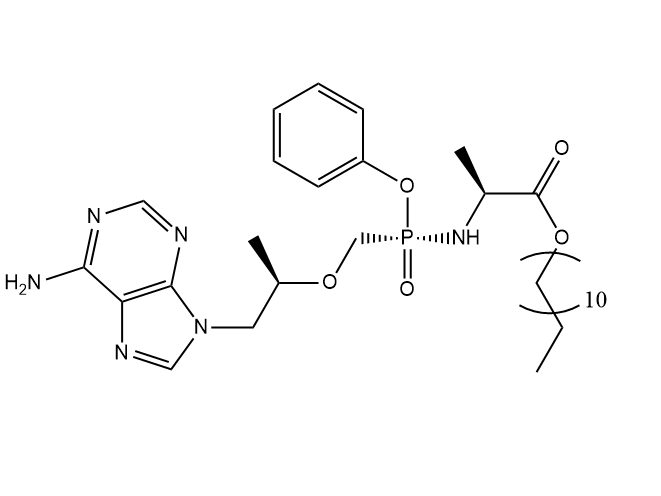Drug information
Tenofovir ProTide Nanoformulation
Not provided
Small molecule
NM1TFV is a novel ultra-long-acting (ULA) tenofovir (TFV) prodrug nanoformulation in preclinical development for chronic hepatitis B virus (HBV) infection and human immunodeficiency virus type 1 (HIV-1). Utilising a modified ProTide approach, the formulation replaces conventional alanyl and short chain amino acid esters with a hydrophobic phenylalanine-docosyl ester linkage to enhance lipophilicity and intracellular delivery of TFV. This modification results in an extended TFV half-life and improved antiviral potency against both HBV and HIV-1. Preclinical studies indicated prolonged drug release profiles and stability for NM1TFV relative to nanoformulated TAF, with IM NM1TFV achieving suppression of HBV replication for 3 months, and concentrations above HIV-1 EC90 in PBMCs for 2 months.
Formulation is in preclinical development and not yet approved in any jurisdiction.
Unknown
Therapeutic area(s)
- HBV
- HIV
- Treatment
Administration route
Intramuscular
Associated long-acting platforms
Aqueous drug particle suspension, Solid Drug Nanoparticles
Use of drug
- Administered by a community health worker
- Administered by a nurse
- Administered by a specialty health worker
Not provided
Dosage
Not provided
Not provided
Not provided
The preclinical NM1TFV formulation suppressed HBV replication for 3 months after a single parenteral injection.
Not provided
Not provided
Formulations
Compare
Ultra Long-Acting Tenofovir ProTide
Associated technologies
Not provided
Comment & Information
Developer(s)

Exavir Therapeutics is a biopharmaceutical company focused on developing ultra-long-acting therapeutics for chronic viral infections and CNS disorders. Headquartered in San Francisco, CA, they utilise prodrug nano-formulation technology to extend the half-life of drugs. Their current research focus primarily targets HIV, with the goal of improving treatment adherence and patient outcomes.
Drug structure
Scale-up and manufacturing prospects
Production scale-up viability for NM1TFV solid drug nanoformulations by high-pressure homogenization and/or wet bead milling processes have been established.
Not provided
Lipophilic ProTides of TFV bearing phenylalanine and alanine amino acid esters were created by replacing optimal short chain alkyl ester groups utilised by conventional ProTide strategies. The docosanol masking ester motif was selected based on inherent lipophilicity and synergy with nucleoside analogs. NM1TFV was synthesised by coupling a phenylalanyl or alanyl docosyl ester to monophenyl TFV in the presence of Et3N. As the conjugation step is moisture sensitive, further improvements to the chemical yields could be achieved by either optimizing the coupling reagents or reaction vessels.
Dynamic light scattering (DLS) and HPLC to measure nanoparticle size, Autoflex maX MALDI-TOF/TOF mass spectrometer to confirm molecular mass.
Excipients
No proprietary excipient used
No novel excipient or existing excipient used
Not provided
Delivery device(s)
No delivery device
There are either no relevant patents or these were not yet submitted to LAPaL
Publications
Srijanee Das et al., An ultralong-acting tenofovir ProTide nanoformulation achieves monthslong HBV suppression. Sci. Adv. 8, eade9582(2022). DOI:10.1126/sciadv.ade9582
Treatment of chronic hepatitis B virus (HBV) requires lifelong daily therapy. However, suboptimal adherence to the existing daily therapy has led to the need for ultralong-acting antivirals. A lipophilic and hydrophobic ProTide was made by replacing the alanyl isopropyl ester present in tenofovir alafenamide (TAF) with a docosyl phenyl alanyl ester, now referred to as M1TFV. NM1TFV and nanoformulated TAF (NTAF) nanocrystals were formulated by high-pressure homogenization. A single intramuscular injection of NM1TFV, but not NTAF, delivered at a dose of TFV equivalents (168 milligrams per kilogram) demonstrated monthslong antiviral activities in both HBV-transgenic and human hepatocyte transplanted TK-NOG mice. The suppression of HBV DNA in blood was maintained for 3 months. Laboratory experiments on HBV-transfected HepG2.2.15 cells affirmed the animal results and the critical role of docosanol in the sustained NM1TFV antiviral responses. These results provide clear “proof of concept” toward an emerging therapeutic paradigm for the treatment and prevention of HBV infection.
Cobb, D.A., Smith, N., Deodhar, S. et al. Transformation of tenofovir into stable ProTide nanocrystals with long-acting pharmacokinetic profiles. Nat Commun 12, 5458 (2021). DOI: https://doi.org/10.1038/s41467-021-25690-5
Treatment and prevention of human immunodeficiency virus type one (HIV-1) infection was transformed through widespread use of antiretroviral therapy (ART). However, ART has limitations in requiring life-long daily adherence. Such limitations have led to the creation of long-acting (LA) ART. While nucleoside reverse transcriptase inhibitors (NRTI) remain the ART backbone, to the best of our knowledge, none have been converted into LA agents. To these ends, we transformed tenofovir (TFV) into LA surfactant stabilized aqueous prodrug nanocrystals (referred to as NM1TFV and NM2TFV), enhancing intracellular drug uptake and retention. A single intramuscular injection of NM1TFV, NM2TFV, or a nanoformulated tenofovir alafenamide (NTAF) at 75 mg/kg TFV equivalents to Sprague Dawley rats sustains active TFV-diphosphate (TFV-DP) levels ≥ four times the 90% effective dose for two months. NM1TFV, NM2TFV and NTAF elicit TFV-DP levels of 11,276, 1,651, and 397 fmol/g in rectal tissue, respectively. These results are a significant step towards a LA TFV ProTide.
Additional documents
No documents were uploaded
Useful links
There are no additional links
Collaborate for development
Consider on a case by case basis, collaborating on developing long acting products with potential significant public health impact, especially for low- and middle-income countries (LMICs), utilising the referred to long-acting technology
Share technical information for match-making assessment
Provide necessary technical information to a potential partner, under confidentiality agreement, to enable preliminary assessment of whether specific medicines of public health importance in LMICs might be compatible with the referred to long-acting technology to achieve a public health benefit
Work with MPP to expand access in LMICs
In the event that a product using the referred to long-acting technology is successfully developed, the technology IP holder(s) will work with the Medicines Patent Pool towards putting in place the most appropriate strategy for timely and affordable access in low and middle-income countries, including through licensing
